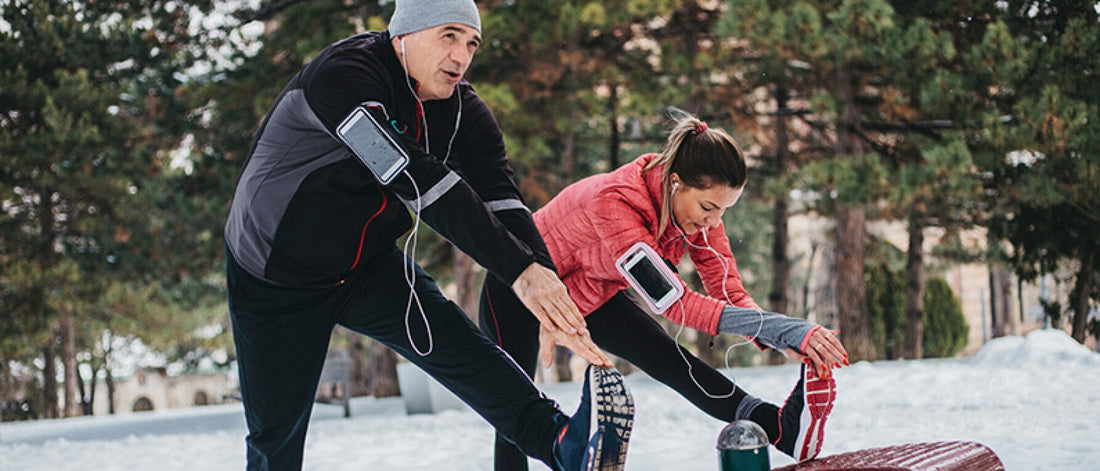It’s recommended that adults get at least 150 minutes (2.5 hours) of moderate aerobic activity or 75 minutes of vigorous aerobic activity—or a combination of both—throughout the week.
During the winter months, fewer daylight hours, colder temps, and seasonal mood shifts can make it tough to stick to a regular workout routine.
However, if you can stay motivated to exercise, your workouts can help you ward off the winter blues and enhance your health. Physical activity not only gives you a rush of endorphins, but it also boosts energy and fends off weight gain. Use these six tips to motivate yourself to work out this winter and achieve your fitness goals.
Although fewer hours of daylight and colder temps can quell your desire to work out, if you can remind yourself that self-care needs to continue all year long, you might find it easier to put on your running shoes, yoga pants, or whatever workout attire your activity of choice requires.
While the studies of the benefits of exercising at different times are compelling, more research is needed. What we know for sure is that exercising—no matter what time of day—is better than not exercising.
Making exercise a regular habit gives you many benefits, including:
Tune in to your natural rhythms and time preferences and determine what works best for you, while keeping in mind that sometimes life will require you to be flexible. Although I like to prioritize my workouts first thing in the morning, sometimes an early morning work call with a colleague in another time zone means I have to work out at night instead. Although I don’t love working out after the sun goes down, particularly in the winter, I can do it so long as I plan accordingly.
If you know you’re going to work out in the evening after work, prep a late-afternoon snack and then set an alarm to remember to eat it, as well as hydrate, about 90 minutes before you exercise. This helps you have enough energy to power through your evening workout.
Although activities such as high-intensity interval training classes at the gym or zipping down ski slopes might come to mind when you think of winter workouts, exercising doesn’t always have to be carried out in the traditional sense or as a stand-alone activity.
Let’s say you have a lot of meal prep to do on a Sunday to get ready for the week ahead. Why not do sets of squats in between recipes? Or if you’re supposed to get together with a friend who lives a few miles away, so long as the weather permits, run or walk to their house rather than drive. You could also plan a get-together that involves physical activity, such as going jogging with a friend or trying out the winter ice-skating rink with your family instead of heading to a movie.
Maybe you need to find a workout buddy or join a group fitness class to help you conquer your goals. Or, maybe you want to hire a personal trainer to keep you motivated whenever you hit the gym. Everyone has different ways to motivate themselves and remain accountable in their daily exercise routine.
Take some time to consider what kind of accountability works best for you. You may find the accountability/expectations framework developed by author Gretchen Rubin helpful in figuring this out. Once you understand what will help keep you accountable to your intention to work out this winter, start putting this valuable information to work.
Researchers who interviewed a group of people about their exercise habits and lifestyles found that enjoyment was a common factor among those who maintained regular exercise routines. In other words, intrinsic motivation appears to be more predictive of long-term adherence, regardless of 20-degree weather and 4:45 p.m. sunsets. Therefore, choose physical activities that you enjoy, whether it’s swimming, walking, dancing, hiking, or any other kind of exercise regimen that is inherently fun and satisfying for you.
If you’ve been a runner for a decade, but you’ve wanted to try hip-hop dancing, what are you waiting for? In addition to working out in a new way, you might also meet people who could help expand your motivation. Or if you typically go to fitness classes at an indoor workout facility, consider trying out a fitness and well-being app that allows you to work out anywhere, or experiment with being physically active outside.
Whatever way you choose to stay motivated to keep moving during the winter months, keep in mind the importance of hydration. Colder air sucks moisture out of the body, yet lower temperatures also suppress thirst. Therefore, it’s easy to become dehydrated in the wintertime, especially while working out. And if your exercise regimen happens in higher altitudes (e.g., skiing, snowshoeing, hiking), the air holds less oxygen, which means you must breathe more rapidly at greater elevations and this exacerbates the dehydration process. Keep your water bottle handy throughout the winter (and always).
*Editor’s Note: The information in this article is intended for your educational use only; it does not necessarily reflect the opinions of the Chopra Center's Mind-Body Medical Group; and is not a substitute for professional medical advice, diagnosis, or treatment. Always seek the advice of your physician or other qualified health providers with any questions you may have regarding a medical condition and before undertaking any diet, supplement, fitness, or other health programs.
Are you ready to experience the healthiest version of yourself? There exists in you a place that is free from disease, never feels pain, is ageless, and never dies. This place is called Perfect Health. Journey there with Oprah and Deepak as they reveal the secrets to lifelong wellbeing. Register for free.
During the winter months, fewer daylight hours, colder temps, and seasonal mood shifts can make it tough to stick to a regular workout routine.
However, if you can stay motivated to exercise, your workouts can help you ward off the winter blues and enhance your health. Physical activity not only gives you a rush of endorphins, but it also boosts energy and fends off weight gain. Use these six tips to motivate yourself to work out this winter and achieve your fitness goals.
1. Keep in Mind: Being Active Is a Year-Round Lifestyle
Regular physical activity is a necessary part of a healthy lifestyle—no matter what season it is. It’s a commitment to the most important person you know: yourself. It’s not selfish to take care of yourself; it’s a necessary prerequisite that allows you to show up for everything and everyone in your life. Self-care also benefits your health. A study of U.S. medical students found that those who implemented self-care routines, including regular exercise, reported less stress and a higher quality of life.Although fewer hours of daylight and colder temps can quell your desire to work out, if you can remind yourself that self-care needs to continue all year long, you might find it easier to put on your running shoes, yoga pants, or whatever workout attire your activity of choice requires.
2. Determine What Time of Day Works Best for You
Research has found that exercising in the morning may offer you the greatest weight loss benefits. A recent study of overweight young adults showed that the participants who exercised before noon lost significantly more weight than those who performed the same workout later in the day. Research on mice found that exercising in the morning increases the body’s ability to metabolize fat and sugar, while exercising later in the day may increase overall metabolism for a longer period of time.While the studies of the benefits of exercising at different times are compelling, more research is needed. What we know for sure is that exercising—no matter what time of day—is better than not exercising.
Making exercise a regular habit gives you many benefits, including:
- Lowered risk of certain types of cancers and heart disease
- Weight control and loss
- Improved mental state
- Stronger muscles and bones
Tune in to your natural rhythms and time preferences and determine what works best for you, while keeping in mind that sometimes life will require you to be flexible. Although I like to prioritize my workouts first thing in the morning, sometimes an early morning work call with a colleague in another time zone means I have to work out at night instead. Although I don’t love working out after the sun goes down, particularly in the winter, I can do it so long as I plan accordingly.
If you know you’re going to work out in the evening after work, prep a late-afternoon snack and then set an alarm to remember to eat it, as well as hydrate, about 90 minutes before you exercise. This helps you have enough energy to power through your evening workout.
3. Combine Your Workout with Another Activity
Time can seem like a scarce commodity, particularly around the winter holidays when friends and family tend to want to get together more and events fill the calendar. Finding ways to combine working out with other things you either have to do or want to do can help you accomplish it all.Although activities such as high-intensity interval training classes at the gym or zipping down ski slopes might come to mind when you think of winter workouts, exercising doesn’t always have to be carried out in the traditional sense or as a stand-alone activity.
Let’s say you have a lot of meal prep to do on a Sunday to get ready for the week ahead. Why not do sets of squats in between recipes? Or if you’re supposed to get together with a friend who lives a few miles away, so long as the weather permits, run or walk to their house rather than drive. You could also plan a get-together that involves physical activity, such as going jogging with a friend or trying out the winter ice-skating rink with your family instead of heading to a movie.
4. Figure Out What Will Keep You Accountable
Some people need another person to help hold them accountable. Others rely on some kind of fitness club membership to ensure that they work out regularly. Both of these are examples of external accountability. Then there are other people who feel like they’re letting themselves and their health down if they don’t show up for their workouts. This is an example of internal accountability.Maybe you need to find a workout buddy or join a group fitness class to help you conquer your goals. Or, maybe you want to hire a personal trainer to keep you motivated whenever you hit the gym. Everyone has different ways to motivate themselves and remain accountable in their daily exercise routine.
Take some time to consider what kind of accountability works best for you. You may find the accountability/expectations framework developed by author Gretchen Rubin helpful in figuring this out. Once you understand what will help keep you accountable to your intention to work out this winter, start putting this valuable information to work.
5. Do What You Love
In the field of psychology, some experts believe that people choose their behavior based on either intrinsic motivation or extrinsic motivation. When you have intrinsic motivation, you choose your behavior because of pure interest or enjoyment. The behavior itself is the reward. For example, if you love cycling, it’s not hard to get up early to fit in a ride. With extrinsic motivation, you do something because of factors outside yourself—such as a desire to gain approval (or avoid disapproval), earn a reward (such as a good grade or a paycheck), or win a trophy. The behavior is primarily motivated not by the love of the activity but from the reward that follows.Researchers who interviewed a group of people about their exercise habits and lifestyles found that enjoyment was a common factor among those who maintained regular exercise routines. In other words, intrinsic motivation appears to be more predictive of long-term adherence, regardless of 20-degree weather and 4:45 p.m. sunsets. Therefore, choose physical activities that you enjoy, whether it’s swimming, walking, dancing, hiking, or any other kind of exercise regimen that is inherently fun and satisfying for you.
6. Also, Try Something New
Just as doing what you love can be a surefire motivational strategy, so can trying something new. When you switch up your routine, your mind and body benefit. The brain feels excitement over a new challenge, which can spark motivation. And when it comes to the body, the American Council on Exercise reports that varying your exercise routine may speed up your results and help you avoid plateaus. Additionally, adding variety to your workouts is a good way to prevent or avoid injuries, particularly those that stem from overuse. Complacency due to boredom is directly linked to a higher probability of error, which in the case of exercise could manifest as incorrect form and a greater risk of injury.If you’ve been a runner for a decade, but you’ve wanted to try hip-hop dancing, what are you waiting for? In addition to working out in a new way, you might also meet people who could help expand your motivation. Or if you typically go to fitness classes at an indoor workout facility, consider trying out a fitness and well-being app that allows you to work out anywhere, or experiment with being physically active outside.
Whatever way you choose to stay motivated to keep moving during the winter months, keep in mind the importance of hydration. Colder air sucks moisture out of the body, yet lower temperatures also suppress thirst. Therefore, it’s easy to become dehydrated in the wintertime, especially while working out. And if your exercise regimen happens in higher altitudes (e.g., skiing, snowshoeing, hiking), the air holds less oxygen, which means you must breathe more rapidly at greater elevations and this exacerbates the dehydration process. Keep your water bottle handy throughout the winter (and always).
*Editor’s Note: The information in this article is intended for your educational use only; it does not necessarily reflect the opinions of the Chopra Center's Mind-Body Medical Group; and is not a substitute for professional medical advice, diagnosis, or treatment. Always seek the advice of your physician or other qualified health providers with any questions you may have regarding a medical condition and before undertaking any diet, supplement, fitness, or other health programs.
Are you ready to experience the healthiest version of yourself? There exists in you a place that is free from disease, never feels pain, is ageless, and never dies. This place is called Perfect Health. Journey there with Oprah and Deepak as they reveal the secrets to lifelong wellbeing. Register for free.






















